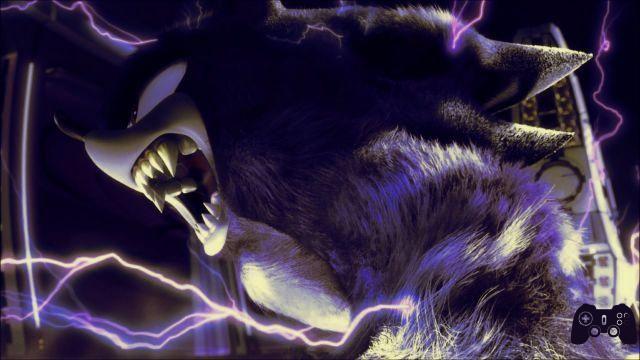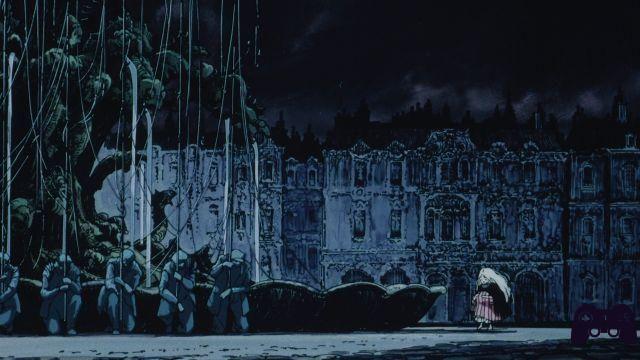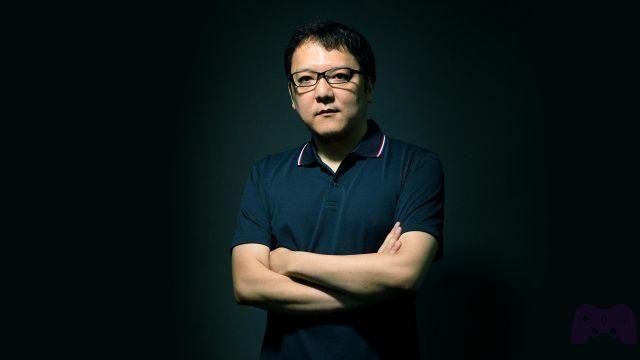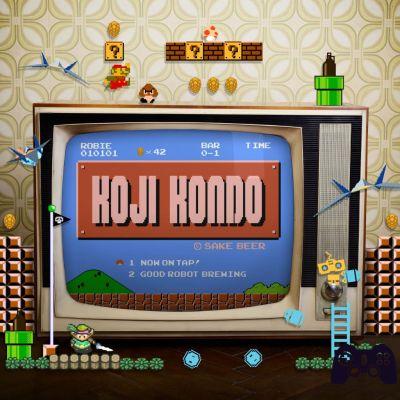
You don't know who he is Koji Kondo? What if I told you instead that you have all come into contact with his art at least once?
It is known, often and willingly Nintendo he manages to enclose something magical in the code strings of his games. Very often this magic is given by the gameplay and its mechanics, but in all its games a fundamental role is often dedicated to music. If at least once you have gotten excited about Nintendo music, you should probably thank this nice-faced Japanese that we are going to talk about today!
Childhood, influences and entry into Nintendo
Koji Kondo was born in Nagoya (Japan) on August 13, 1961 and his passion for music blossomed from childhood, in fact already during kindergarten he expressed the desire to learn to play an instrument. For this reason, at the age of 5, he began attending children's music lessons at the Yamaha Music School, where he slowly learned to play theElectone (electric organ) while at school he learned both to play the marimba and the rudiments of ensemble music. Throughout his childhood and adolescence Kondo never separates from his organ, improving more and more both on a purely technical and compositional level, trying to assimilate as many influences as possible. Unexpectedly, his musical training does not include classical music (although he does not despise it) but mainly electronic music, pop e rock. Precisely because of his passion for the sequencer and synth, the desire to work in the field of sound effects and sound engineering. This will lead him to enroll in the Osaka School of Arts where it comes into contact with the musical culture of Classic rock and Progressive. It will be during his high school years that Kondo discovers groups that will leave an indelible mark on him such as: Deep Purple; Emerson, Lake & Palmer; Casiopeia and the Naniwa Express. Our composer in the making is in fact bewitched by electronic sounds and his expressive abilities (a similar argument should be made for jazz) but instead denies the look of that musical current. Too bad, I would have given anything to see him all dressed up like a rock star while playing covers with his school friends!
The young musician's life, however, changed drastically in 1983 when a friend of his told him that the Nintendo posted job postings for the position on their school's bulletin board Sound programmer
Other development companies such as Namco were in fact starting to pay more and more attention to the music of their products and Nintendo could not help but keep up. In those years Kondo approached the world of arcade games and thought that composing music for video games could have been a great job as it mixed two of his great passions. He then replied to the announcement and was hired by the big N almost confidently as he was not even asked for a trial demo!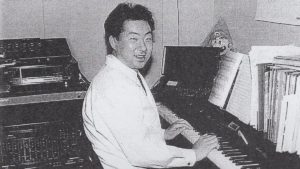 It amuses me a lot to think about how the Nintendo world would be different today if they had asked him and he wouldn't have passed the "test". At the time, the only two people working in the sound industry at Nintendo were Hirokazu Tanaka (president of Creatures Inc., one of the 3 companies that own the rights to Pokémon) e Yukio Kaneoka. The latter, however, were very prepared in the field of sound programming and sound engineering but had no knowledge regarding the actual musical composition, in practice the opposite situation to that of Kondo. He then spent the first year as a Nintendo employee in close contact with Kaneoka to learn everything there was to know about sound programming. The sound chip of the Famicom in fact it did not allow to carry midi files on the console, making it compulsory to program the sound via computer with only 3 channels, respectively: melody, harmony and percussion. After composing the music for some titles such as "Punch-Out !!", "Golf" e "Devil World" to understand how to take full advantage of the first Nintendo console, he also tried his hand at writing an instruction manual on how to compose music using the “Famicom Basic” peripheral. In what only employee with knowledge of music composition, he was given the task of making the music of the Nintendo games universally recognizable and fuck if he succeeded! He then became part of the company's largest business division / development team, namely the Nintendo Entertainment, Analysis and Development (Nintendo EAD) as a principal member of the Sound Group. This choice of Nintendo forever changed the way of conceiving videogame music.
It amuses me a lot to think about how the Nintendo world would be different today if they had asked him and he wouldn't have passed the "test". At the time, the only two people working in the sound industry at Nintendo were Hirokazu Tanaka (president of Creatures Inc., one of the 3 companies that own the rights to Pokémon) e Yukio Kaneoka. The latter, however, were very prepared in the field of sound programming and sound engineering but had no knowledge regarding the actual musical composition, in practice the opposite situation to that of Kondo. He then spent the first year as a Nintendo employee in close contact with Kaneoka to learn everything there was to know about sound programming. The sound chip of the Famicom in fact it did not allow to carry midi files on the console, making it compulsory to program the sound via computer with only 3 channels, respectively: melody, harmony and percussion. After composing the music for some titles such as "Punch-Out !!", "Golf" e "Devil World" to understand how to take full advantage of the first Nintendo console, he also tried his hand at writing an instruction manual on how to compose music using the “Famicom Basic” peripheral. In what only employee with knowledge of music composition, he was given the task of making the music of the Nintendo games universally recognizable and fuck if he succeeded! He then became part of the company's largest business division / development team, namely the Nintendo Entertainment, Analysis and Development (Nintendo EAD) as a principal member of the Sound Group. This choice of Nintendo forever changed the way of conceiving videogame music.
From promise to legend
Super Mario Bros. and The Legend of Zelda
The first years of experimentation with the Famicom sound chip allowed Kondo to make the most of the details square sound waves that it produced. In fact, he realized that they produced a much clearer sound by using slightly longer intervals of time between notes. In this way the sound was not only clearer but also much deeper, managing to exploit the 3 available channels almost as if they were 5.
All this led Kondo to become a real legend in the world of videogame music
That is, when between 1985 and 1986 Nintendo published respectively what are undoubtedly the greatest strokes of genius of that joker of the maestro Shigeru MiyamotoThese are: Super Mario Bros. and The Legend of Zelda.
As for the soundtrack of the first title entirely dedicated to the most famous plumber in the world, Kondo took inspiration from both the melodies of Latin and Portuguese music and from
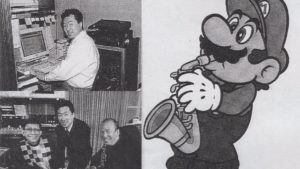
Below left we can see Kondo together with Kōichi Sugiyama, composer of the music of Dragon Quest (left) and Sadao Watanabe (right)
Japanese artists of the moment such as the Bossanova-influenced jazzman Sadao Watanabe and the fusion group T-Square. This intersection of genres led to the composition of one of the best known themes of all time that led the musician to the Olympus of the videogame world. Its fast-paced rhythm and that damn catchy melody enters the player's brain even if it were a summer hit!
Come on, who hasn't whistled Mario's tune at least once?
In fact, his music contributed to better characterize not only the mustachioed protagonist but also the entire game world. This was possible because Kondo worked closely with the developers that provided him with images of the game prototype, thus allowing him to intuit the essence of each setting. To avoid boring the player, he composed extremely catchy little musical segments repeated indefinitely accompanied by extremely recognizable sound effects. In fact, I could make myself nice regardless of a person if I notice that the ringtone for cell phone notifications is the sound we hear every time Mario collects a coin or a mushroom! This idea came to him when the upper floors of Nintendo asked him to insert a specific sound for Mario's jumps; initially Kondo did not appreciate the idea but then he was convinced and accepted the proposal as long as they would make him use a nice and recognizable sound. The soundtrack of the first Mario, however, also includes other masterpieces such as the"Underground Theme" and l '"Underwater Theme", capable of giving the player a sense of fairytale anguish and a sense of tranquility out of the ordinary respectively.
"The Legend of Zelda" it allowed the master Kondo - at this point in the story I think it is unfair to deny him this name - to experience even more. The first title of the fairy tale made in Nintendo was in fact published in Japan as the launch title of the peripheral Famicom Disk System (FDS) which, due to poor sales, was never released outside of the Rising Sun. This forced Nintendo to release the title in the classic cartridge format but introducing a battery inside that allowed saving just like the floppy disks of the FDS. 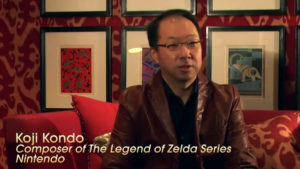 The peripheral also possessed a improved sound chip which allowed Kondo to use a much wider range of sounds as no longer limited by square sound waves. Before the composition phase, in fact, Kondo analyzed the sound waves of the instruments he intended to use with specific programs and then reproposed them within his compositions in the game thanks to the new sound chip. This time the collaboration with the developers was less, in fact they only gave the composer little information about the title and the instruments to use as "fountain of life" and "fanfare". I warmly thank Miyamoto and company for their negligence which allowed Kondo to have total compositional freedom. Very important was the technique of vibrato, unusable with the sound chip of the basic Famicom, which allowed to obtain sounds very similar to those of an analog synth.
The peripheral also possessed a improved sound chip which allowed Kondo to use a much wider range of sounds as no longer limited by square sound waves. Before the composition phase, in fact, Kondo analyzed the sound waves of the instruments he intended to use with specific programs and then reproposed them within his compositions in the game thanks to the new sound chip. This time the collaboration with the developers was less, in fact they only gave the composer little information about the title and the instruments to use as "fountain of life" and "fanfare". I warmly thank Miyamoto and company for their negligence which allowed Kondo to have total compositional freedom. Very important was the technique of vibrato, unusable with the sound chip of the basic Famicom, which allowed to obtain sounds very similar to those of an analog synth.
For the game's intro screen, Kondo made a kind of 8-bit cover by Bolero by the French composer Maurice Ravel. At an already advanced stage of the title's development, however, he realized that copyright rights were still in force for that specific composition, making it impossible to include it in the final game. So it was that in a single day, in order not to delay the launch of the FDS, Kondo's mind gave birth to what is now for everyone the initial theme of The Legend of Zelda.
To compose the theme Kondo decided to start from a rearrangement of the overworld theme already present in the game; so it was that another of the most popular themes of the videogame world saw the light that still today infuses courage and at the same time melancholy to all those who want to venture into the world of Hyrule.
Both games are based on the simple - and abused at the time - concept of "saving the princess", but there is a basic difference: while Mario is based on action and dynamism (you move from one point to another B), Zelda instead is based on the exploration of dungeons and the game world. The two titles were developed simultaneously and Kondo then composed always keeping this difference in mind: in fact, in Mario the music is more dynamic, speeds up or changes based on power-ups (or in more recent titles also based on the avatar's movements); in Zelda, on the other hand, the music serves to create the atmosphere and accompany the player.
From Mario and Zelda to Super Nintendo
After the birth of the two most important Nintendo series, Kondo devoted himself both to composing the music for Mario's sequels, maintaining the characteristic sense of action and dynamism of the first chapter, and to other games supported by the FDS. He also composed music for "Doki Doki Panic”Brought to the West under the title of "Super Mario Bros 2" (for which Kondo then rewrote the entire soundtrack) as it was believed that the original sequel to the 1985 title was too difficult for us Westerners. However, he did not work on "Zelda 2: The Adventure of Link" and "Zelda: Link's Awakening" to complete all the other projects. In 1990, the new 16-bit Nintendo machine was released in Japan: the Super Famicom (later arrived in the rest of the world under the name of Super Nintendo Entertainment System o SNES) which forced Kondo to reflect on what path music in video games should take for him. The SNES in fact allowed to use an even wider range of sounds than the FDS with an even better quality (although it was not yet possible to import MIDI files).
Would it therefore have been better to imitate “normal” music or to give a new direction to videogame music?
It was during the development of "Super Mario World", launch title of the SNES, which Kondo understood which was the way to take: to use once again sounds similar to real existing instruments but to create among the latter combinations that it was not possible to hear very often in real life (such as a banjo and a steel drum) harmonizing everything thanks to the SNES sound chip.
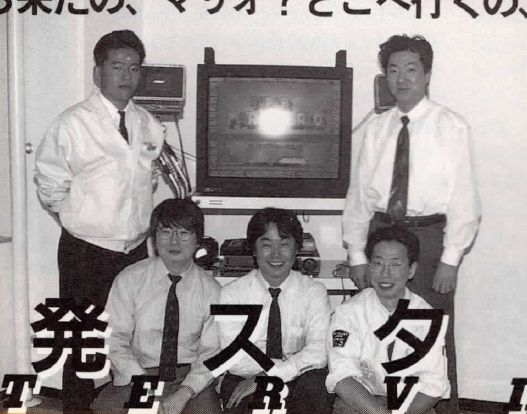
The main members of the Super Mario World development team. Left to right: Hideki Konno, Toshihiko Nakago, Shigeru Miyamoto, Takashi Tezuka, Koji Kondo
Kondo's experimenting soul came out again like a damned river in flood.In fact, he began to try every type of instrument and possible combination, always keeping an eye on the capacity of the cartridges (a problem that has accompanied him since the first compositions on Famicom). Most of the themes of the levels were actually rearrangements of a single main melody, while the themes of the game world - even if very simple and short - managed to characterize each setting perfectly. In short, both Kondo and Nintendo added a new brick to their wall of masterpieces.
Also during 1990 Kondo carried out his first experience from sound director for the title "Pilotwings", for which he composed only a theme to make the rest of the staff understand what the direction of the project was. For the following year, instead, the release of the new adventure of the hero of the legend Link was expected with what is remembered by many as one of the best titles of the saga, "The Legend of Zelda: a Link to the Past". During the title programming period, Kondo and Miyamoto worked closely together; although Mario's father was actually his boss, the two established a relationship of trust and mutual respect during this period.
Miyamoto gave him total carte blanche to the composer as he probably understood that Zelda could bring out the best in him.The two simply discussed for a long time Miyamoto's inspirations that would later become the settings in the game. For Kondo it was a difficult challenge to properly frame the emotions that his music should have aroused in the player and adapt them to the numerous settings of the title, for this reason he decided to ask the developers for confirmation and advice only after completing a composition. And luckily, who knows what strange stuff would come out! However, we can consider it a challenge won hands down by our Koji who in this chapter of the saga introduces many of the compositions that have become extremely popular among fans (such as the theme of Hyrule Castle and the Calbaric village or Kakariko if you prefer) thanks to a perfect mix of different genres and unforgettable melodies.
Before finally leaving the 16-bit console, Kondo worked on two other projects: "Star Fox" (1993) and "Yoshi's Island" (1995).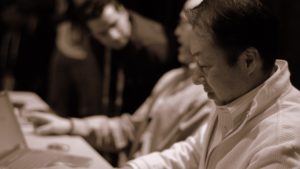 As for Star Fox he decided to leave the role of composer in favor of two new recruits of the company, Soyo Oka and Hajime Harisawa and assumed the role of director of sound effects and general supervisor. He then worked completely alone on the composition of the music for "Super Mario World 2: Yoshi's Island", managing to overcome in all respects the work done 5 years earlier on "Super Mario World" by inserting Caribbean and African sounds that he loved to listen to at that time. The music of the latter title marries so well with its graphic style that it is difficult to imagine it without those synthesized bonghetti that accompany the player in almost all of his adventure.
As for Star Fox he decided to leave the role of composer in favor of two new recruits of the company, Soyo Oka and Hajime Harisawa and assumed the role of director of sound effects and general supervisor. He then worked completely alone on the composition of the music for "Super Mario World 2: Yoshi's Island", managing to overcome in all respects the work done 5 years earlier on "Super Mario World" by inserting Caribbean and African sounds that he loved to listen to at that time. The music of the latter title marries so well with its graphic style that it is difficult to imagine it without those synthesized bonghetti that accompany the player in almost all of his adventure.
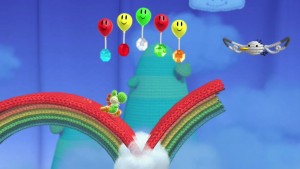
To learn more:
Yoshi's Woolly World
Part 4: 64-bit and adaptive scoring
By now he was no longer forced to do everything alone and preferred to give space to his colleagues in the sound effects department with whom he was constantly confronted.The Sound Group of the Nintendo EAD led by Kondo was expanding more and more, which allowed him to devote himself solely to composing in the next 64-bit generation. Throughout the period of Nintendo 64 (released in japan in june 1996) in fact Kondo no longer held the position of sound programmer or sound effects supervisor.
As already happened with the SNES, the launch of the new Nintendo console was accompanied by a new title of the mustachioed plumber (as usual considered one of the best in the saga as well as in the entire videogame history): "Super Mario 64".
One of the few problems Kondo encountered while working on the title was related to the limitations on the number of sounds that could be played simultaneously (this varied from scene to scene but it was never possible to go beyond 16 sounds simultaneously). For the title that brought Mario into three dimensions for the first time, Kondo decided to insert sounds from multiple musical cultures such as: the Indian sounds for the Big Boo theme, the lively jazz typical of brass wind instruments for the Bob level -omb's Battlefield and the almost heavy-metal sounds to emphasize the climax during the clashes with the serial kidnapper of princesses Bowser. Kondo also rearranged the main theme of the saga using numerous percussions as key instruments of the composition to make it even more dynamic. Thanks to this intuition, in fact, the player indirectly understood that it was Mario, but that in some way he was different even if always faithful to his original spirit. During the development of the title it was then thought to modify the classic sound of Mario's jumps with a series of different "yahooo!" (which have now become equally iconic thanks to the voice of Charles Martinet) as the obsessive repetition of the same sound would have easily bored the player while exploring new worlds in three dimensions.
In 1997 he collaborated with Hajime Wakai for the composition of the soundtrack of "Star Fox 64".
For every artist, however, that work always arrives that will remain his best work for everyone, it was the same for Kondo.
FOR THE LAST TIME IN HIS CAREER (UNFORTUNATELY I WOULD ADD) KONDO TAKES RESPONSIBILITY TO WRITE A ENTIRE SOUNDTRACK ONLY BY ITSELF.In fact, in 1998 the masterpiece arrives, the opera magna, that stroke of creativity that seems to descend directly from God with the help of the holy spirit or who knows what hard drug: "The Legend of Zelda: Ocarina of Time". The greatest difficulty was that of respecting the great variety but at the same time unity of Hyrule on a musical level. The new Hyrule in three dimensions in fact included races, cities, characters and settings even more detailed and characterized than "A Link to the Past". It was therefore vital for Kondo to test all of hers musical versatility to keep the soundtracks of the series high. It was possible not only to maintain the level of the previous titles but even to raise it thanks to two factors:
- THEadaptive scoring which allowed the music to change based on the player's actions or changes in the game world. Kondo managed to do this by composing 15-second segments of the theme with different chord progressions or different instruments, leaving a complex algorithm to determine the order of these segments. Thanks to this mechanism, the music changed according to the time of day, if you approached an enemy or according to the climate. Unfortunately, I'm a little too young to be surprised by such a thing (let's say playing Ocarina of Time at one year would have been quite difficult), but I imagine that at the time contributed particularly to the immersion of the players.
- For the first time (but not the last in the series) Kondo's compositions were integrated into both gameplay and storyline thanks to the introduction of the legendary Ocarina of Time, thus managing to enter the players' brains and never leave it again. The player had to learn to play his melodies to continue the adventure. Okay, after a while it got boring to have to wait every time before I could activate the song effect, but personally I prefer to wait a bit and make my ears ejaculate rather than not waiting before a teleport and shit like that. In some places, the music is simply a variation of an ocarina piece learned in that area, creating a indissoluble link between the player, Link and the game world.
But what is striking about this soundtrack is the emptiness. Yes, the void.
Kondo tries to evoke feelings with silence, with the void between one note and another, focusing more on the space between the notes and their connection than on the notes themselves. It is almost as if Kondo managed to make the notes dialogue with each other to frame the gameplay and convey sensations to the player.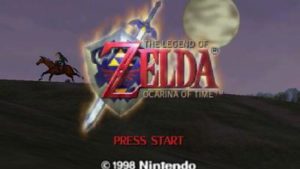 Think at the game intro, at the intervals between notes of the harp and ocarina, it is pure magic that accompanies Link and Epona as they race across the plain of Hyrule. It is in those intervals that the player's emotions enter, emotions that will never leave him again. How not to mention the Zelda's Lullaby and Epona song that with their relaxing and melancholic melodies transport us to a world that manages to be fairytale even if full of dangers in every corner? Despite the absence of some compositions engraved in the memory of the players, the new soundtrack composed by Kondo left the gaming world completely bewitched. Many specialized sites (such as IGN or GameSpot) have defined it as one of the best videogame soundtracks ever and the popularity of Kondo's title and compositions have contributed to an exponential increase in the number of people learning to play the ocarina (including myself). Only a year later was it published "The Legend of Zelda: Majora's Mask", sequel to Ocarina of Time and probably the most creepy and disturbing title ever made by Nintendo. Within the title, the importance already attributed in the past to the Ocarina of Time was maintained, which this time is transformed into various instruments based on which of the 3 masks of the races we wear. But to reflect the evil of Majora's mask and the sense of loneliness that Termina's parallel world settings wanted to provoke, Kondo decided together with Toru Minegishi (co-composer) to insert sounds from China. Precisely because of the more sinister and disturbing nature of the title, we find here in an even more present way the "void" within the compositions of Kondo already mentioned previously that manages to make the player feel contrasting emotions, typical of the world of Termina. If you have not yet understood what I mean, I recommend that you listen to it in the dark and alone Song of Healing composed for this title and focus on the particular touch that the master Koji Kondo manages to have on the piano.
Think at the game intro, at the intervals between notes of the harp and ocarina, it is pure magic that accompanies Link and Epona as they race across the plain of Hyrule. It is in those intervals that the player's emotions enter, emotions that will never leave him again. How not to mention the Zelda's Lullaby and Epona song that with their relaxing and melancholic melodies transport us to a world that manages to be fairytale even if full of dangers in every corner? Despite the absence of some compositions engraved in the memory of the players, the new soundtrack composed by Kondo left the gaming world completely bewitched. Many specialized sites (such as IGN or GameSpot) have defined it as one of the best videogame soundtracks ever and the popularity of Kondo's title and compositions have contributed to an exponential increase in the number of people learning to play the ocarina (including myself). Only a year later was it published "The Legend of Zelda: Majora's Mask", sequel to Ocarina of Time and probably the most creepy and disturbing title ever made by Nintendo. Within the title, the importance already attributed in the past to the Ocarina of Time was maintained, which this time is transformed into various instruments based on which of the 3 masks of the races we wear. But to reflect the evil of Majora's mask and the sense of loneliness that Termina's parallel world settings wanted to provoke, Kondo decided together with Toru Minegishi (co-composer) to insert sounds from China. Precisely because of the more sinister and disturbing nature of the title, we find here in an even more present way the "void" within the compositions of Kondo already mentioned previously that manages to make the player feel contrasting emotions, typical of the world of Termina. If you have not yet understood what I mean, I recommend that you listen to it in the dark and alone Song of Healing composed for this title and focus on the particular touch that the master Koji Kondo manages to have on the piano.
The legacy and the tireless desire to compose
After the release of Majora's Mask our Kondo focused more on managing as general supervisor the Sound Team of the Nintendo EAD division, responsible for both the composition of the soundtracks and the sound effects for most of Nintendo's flagship series (including the same Mario and Zelda, Pikmin and Animal Crossing but also all the dedicated spin-offs to Mario). To increase productivity, but also the quality and variety of compositions of Nintendo games, Kondo decided to hire several new composers.
The new recruits of the Nintendo EAD Sound Group have been trained by the master to follow his own principles (fun music, stylistic variety and in-game interactivity) for the creation of increasingly powerful and impacting video game music.
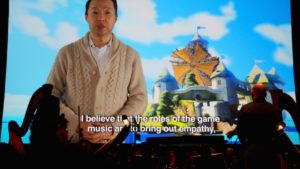
"I believe that the role of music in video games is to bring empathy to light"
For Kondo, in fact, what really matters is be able to describe what is happening on the screen on a sheet of staff, to enclose in those 5 staves a feeling that is able to connect the player to the game world both through the melody and through the interaction with the game itself. Thanks to his ideas Koji Kondo has created a real one within Nintendo legacy of composers which, following its principles, have given life to timeless soundtracks. Among these we find for example: Kazumi Totaka; Hajime Wakai; Toru Minegishi; Kenta Nagata; Ryo Nagamatsu; Shiho Fujii; Manaka Kataoka; Atsuko Asahi and Satomi Terui. In fact, all these artists work in groups (almost always of 3) for each new Nintendo title, managing to keep all the teachings of the master Kondo alive. The latter, however, did not retire, on the contrary, the desire to compose never leaves him and, despite now his main role is that of supervisor, he regularly returns to compose for the flagship Nintendo series (mainly Mario and Zelda). Among his most beautiful compositions of this period (often made to give composers an idea of how the work should proceed and then inserted into the game) we can find for example: Delfino Plaza ("Super Mario Sunshine"), the 'Observatory ("Super Mario Galaxy"), all the arrangements of his old compositions for the "Super Smash Bros" series and for all the remakes of the reference works, the opening of "Zelda: Skyward Sword" and much more . Starting from 2015, with the merger between the two business divisions of Nintendo (EAD -Entertainment, Analysis and Development- and SPD -Software, Planning and Development-), Kondo has moved to the role of Director of the Sound Group of the newly formed Nintendo Entertainment, Planning and Development (EPD).
Final
Each note of Kondo leaves a groove in the heart, gives unique emotions and sensations to the player.The music of this great composer has given prestige to the history of the videogame, showing everyone how with music the characteristics of a videogame work can be emphasized and enhanced. How can you not be ecstatic listening to (just to mention some of what for me are his best compositions) Zelda's Lullaby, the intro of Ocarina of Time, the Mario Galaxy Observatory or Delfino Plaza? Thanks to his dream melodies and the many dissonances used in an extremely wise way, Koji Kondo has embellished the world of our medium with tangible and undeniable art, leaving the world some of the most exciting and recognizable music composed in recent decades as only John Williams in the world of cinema has been able to do. I do not deny that often the music that this nice-faced little man composed for The Legend of Zelda series lulls my sleep, taking the place of the dear and nostalgic lullabies that accompanied my childhood. Precisely because he made me relive with his art the emotions that I thought were dormant forever, I decided to dedicate my time and my words to the master Kondo, to thank him and allow all of you readers to know his story! I leave you below a video of his performance at the VGA in 2014 together with the Imagine Dragons, enjoy!
!




